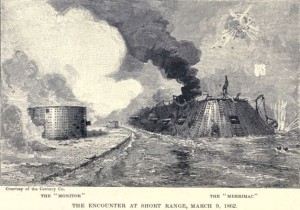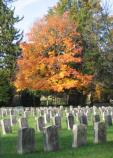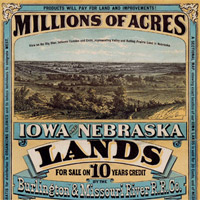Julia Ward Howe published “Battle Hymn of the Republic” as a poem in The Atlantic Monthly in 1862. The poem was a result of a visit she made to a Union army camp during the Civil War. Soldiers had asked her to create the lyrics of a “fighting song” to match a melody that already existed. She awoke one dawn and the words began to form the verses. She got up and wrote down the poem immediately. Children can read the lyrics and view a photograph of Julia Ward Howe at: Lyrics. Children can listen to the song at: Battle Hymn of the Republic.
 Monitor and Merrimac, two ironclad ships, battled in 1862 during the Civil War. The Merrimac, a Confederate vessel, and the Monitor, a Union ship, exchanged fire. Both pulled away after about two hours. Neither ship was severely damaged. Children could learn more at: Monitor and Merrimac.
Monitor and Merrimac, two ironclad ships, battled in 1862 during the Civil War. The Merrimac, a Confederate vessel, and the Monitor, a Union ship, exchanged fire. Both pulled away after about two hours. Neither ship was severely damaged. Children could learn more at: Monitor and Merrimac.
Cinco de Mayo is celebrated in Mexico and the United States. The Battle of Puebla took place in 1862. General Ignacio Zaragoza led his Mexican army, outnumbered three to one, against Napoleon III’s French forces. Zaragoza won. Speeches, festivals, and parades are held nationwide. Young children could read Cinco de Mayo by Mary Dodson Wade. Idea: Children could have a Cinco de Mayo celebration. A piñata should be included.
Merrimack was destroyed by the Confederate Navy in 1862. Southern military leaders thought advancing Union troops might capture the ironclad, so Confederate officials sank the ship.
 Department of Agriculture was created in 1862. The department has 29 different agencies and employs 100,000 people. Its goals are: “We have a vision to provide economic opportunity through innovation, helping rural America to thrive; to promote agriculture production that better nourishes Americans while also helping feed others throughout the world; and to preserve our Nation’s natural resources through conservation, restored forests, improved watersheds, and healthy private working lands.” Children can visit the department’s nutrition website at: USDA for Kids.
Department of Agriculture was created in 1862. The department has 29 different agencies and employs 100,000 people. Its goals are: “We have a vision to provide economic opportunity through innovation, helping rural America to thrive; to promote agriculture production that better nourishes Americans while also helping feed others throughout the world; and to preserve our Nation’s natural resources through conservation, restored forests, improved watersheds, and healthy private working lands.” Children can visit the department’s nutrition website at: USDA for Kids.
Homestead Act was created by Congress in 1862. Any person over the age of 21 or who was the head of a family could procure 160 acres of public land. He/she had to be willing to live on it for five years and to make improvements on it. The act enticed between 400,000 and 600,000 families to the West. Children could learn more at: Homestead Act.
United States levied the first income tax in 1862. Any income over $800 was taxed at 3 percent. Idea: Children could translate $800 back then into today’s dollars. They could learn more about the history of the United States income tax at: http://www.infoplease.com/ipa/A0005921.html.

Antietam National Cemetery
Battle of Antietam occurred in 1862. This Civil War battle was called America’s bloodiest day because over 25,000 soldiers were killed on the shores of the Potomac River. Children could learn more at: Battle of Antietam.

USS Monitor
USS Monitor, the iron-clad ship, sank in a storm off Cape Hatteras, North Carolina, in 1862. The Monitor had been built in early 1862. The ship faced the Confederate iron-clad Merrimac on March 9, 1862. Neither ship sustained major damage. The Monitor was being towed by the USS Rhode Island when both ships ran into a storm. Many of the Monitor crew members were saved by the Rhode Island crew. However, sixteen crew members died. Today the Monitor is part of the Monitor National Marine Sanctuary. Divers can roam around the outside of the ship. The Sanctuary is a wonderful repository of information and a catalyst for future experiments and research. Children can visit the Sanctuary’s website at: http://monitor.noaa.gov/. Idea: Young scholars could find out why so many ships have sunk off Cape Hatteras.
